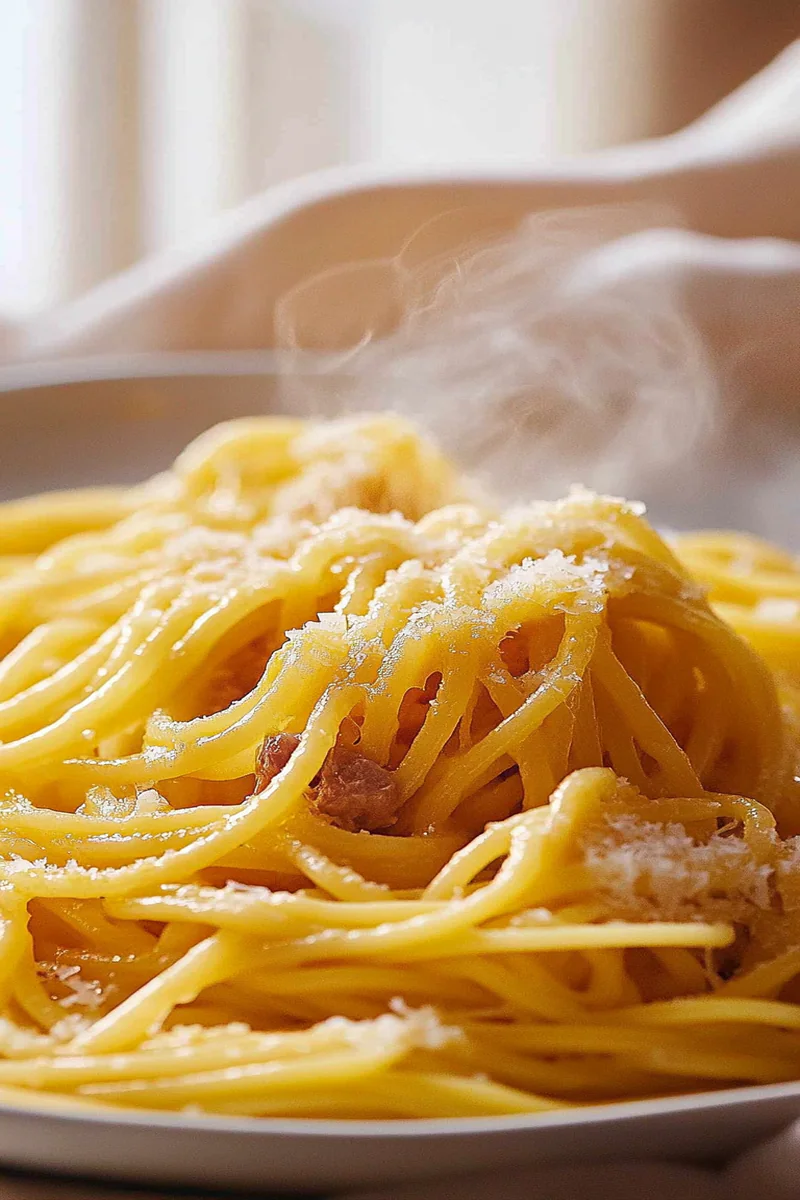Introduction and Quick Summary
Spaghetti carbonara is a classic Italian dish that combines simplicity with rich flavors. Originating from Rome, this creamy pasta recipe features a delicious blend of eggs, cheese, pancetta, and black pepper. The beauty of spaghetti carbonara lies not only in its taste but also in its ease of preparation. In less than 30 minutes, you can whip up this delightful meal that impresses both family and guests alike.
This dish is perfect for weeknight dinners or special occasions. With just a handful of ingredients and straightforward steps, you can create a plate of spaghetti carbonara that rivals your favorite Italian restaurant. The key is using high-quality ingredients to bring out the best flavor. Whether you’re a novice cook or an experienced chef, this recipe will guide you through making an authentic spaghetti carbonara that delivers on taste and texture.
Ready to indulge in this creamy delight? Gather your ingredients and let’s dive into the world of spaghetti carbonara! From understanding the essential components to mastering the preparation technique, you’ll find everything you need right here.
Main Ingredients
Spaghetti
Spaghetti is the star ingredient in this recipe. Opt for high-quality dried spaghetti for the best texture. Typically, 400 grams serves four people well. Cooking it al dente ensures that it retains some bite even after mixing with the sauce. Remember to salt your water generously; it should taste like the sea when cooking pasta.
Pancetta
Pancetta adds a savory depth to spaghetti carbonara. You will need about 150 grams diced pancetta for this recipe. This Italian cured meat provides an irresistible richness and flavor without being overly greasy. If pancetta isn’t available, guanciale or even bacon can be used as alternatives.
Eggs
Using fresh eggs is crucial for achieving the creamy sauce in spaghetti carbonara. You will need three large eggs; two yolks and one whole egg are ideal for creating the perfect balance of creaminess and flavor. The heat from the pasta cooks the eggs gently without scrambling them, resulting in a silky texture that clings beautifully to each strand of spaghetti.
Pecorino Romano Cheese
Pecorino Romano cheese is a traditional choice for this dish due to its sharp flavor profile. Grate about 100 grams before starting your preparation so it’s ready to combine into your sauce seamlessly. This cheese not only enhances flavor but also contributes to the creaminess vital for authentic spaghetti carbonara.
Black Pepper
Freshly cracked black pepper is essential in achieving that characteristic bite in your dish. Use about one teaspoon or adjust according to your preference for spiciness. It complements the richness of the cheese and pancetta while adding aromatic notes that elevate every bite.
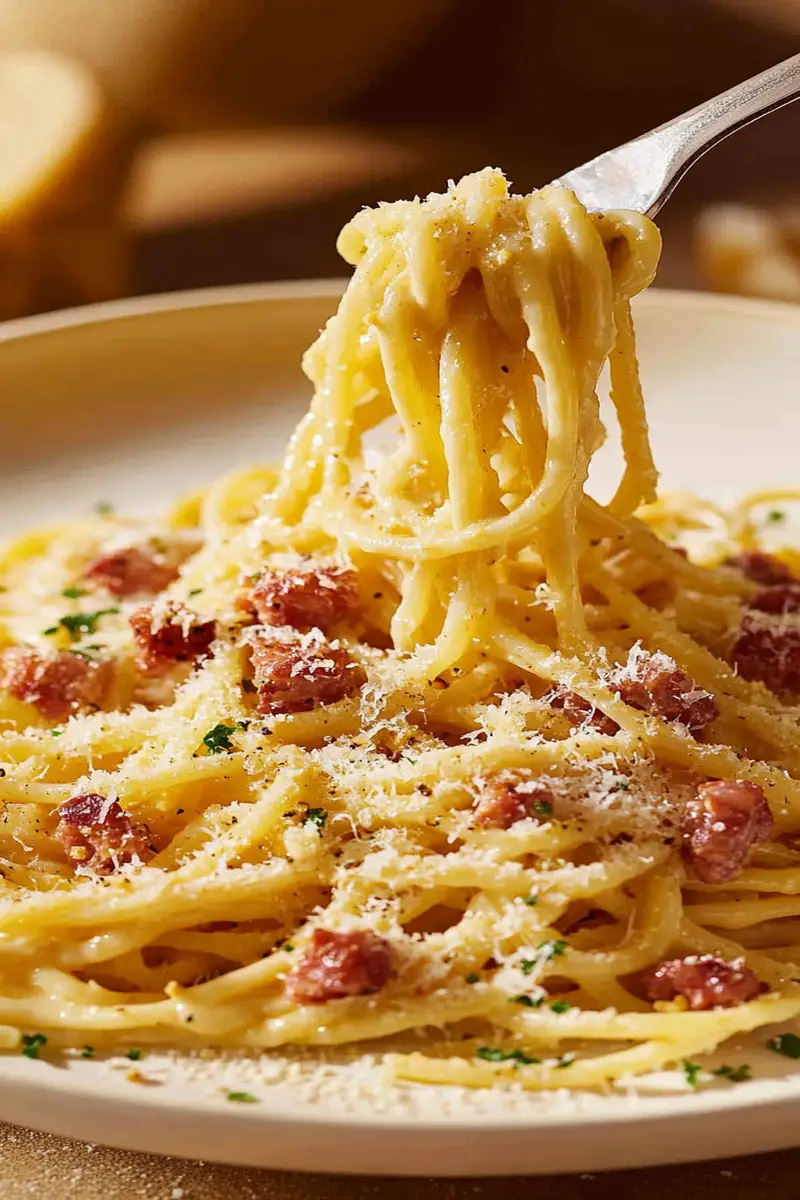
How to Prepare Spaghetti Carbonara
Step One: Cook the Spaghetti
Begin by boiling water in a large pot over high heat. Once it reaches a rolling boil, add salt generously before adding 400 grams of dried spaghetti. Stir occasionally to prevent sticking and cook according to package instructions until al dente—approximately 8-10 minutes depending on thickness. Before draining, reserve about 1 cup of pasta water; this starchy liquid will help create a smoother sauce later on.
Step Two: Prepare Pancetta
While waiting for the pasta to cook, take a large frying pan and set it over medium heat. Add 150 grams of diced pancetta directly into the pan without any oil as it will release its own fat during cooking. Sauté for about 5-7 minutes until crispy and golden brown but be careful not to burn it! Once cooked through, remove from heat but leave it in the pan; it will continue releasing flavor while you prepare the egg mixture.
Step Three: Whisk Eggs and Cheese
In another bowl, crack three large eggs—two yolks and one whole egg—and whisk them together until well combined. Gradually add in 100 grams of finely grated Pecorino Romano cheese along with freshly cracked black pepper (about one teaspoon). Mix until smooth; this mixture will form your creamy sauce once combined with hot pasta.
Step Four: Combine Everything
Once you’ve drained your al dente spaghetti (remembering to reserve some pasta water), quickly add it into the frying pan with cooked pancetta still warm but off heat—you want residual heat without direct flame! Pour over your egg and cheese mixture immediately while tossing vigorously using tongs or forks so that everything coats evenly without scrambling eggs—this step takes practice! If needed, gradually incorporate reserved pasta water until desired creaminess is reached.
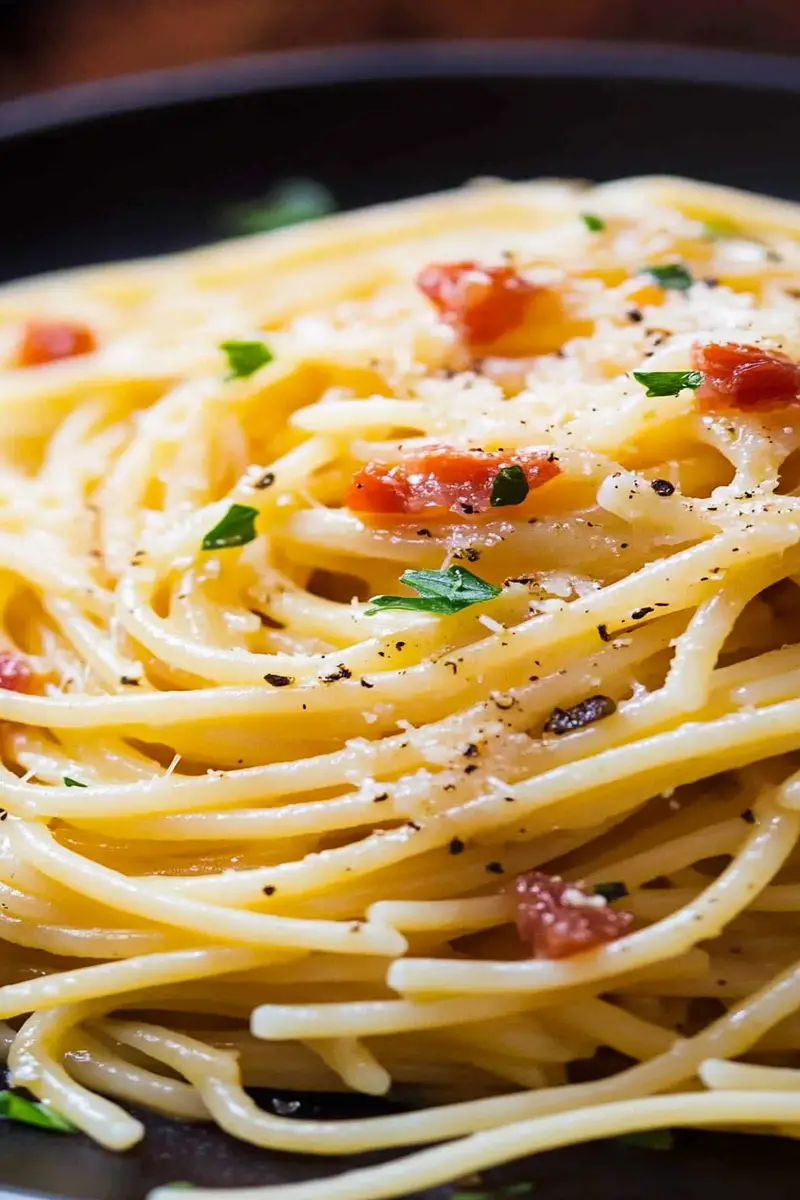
Serving and Storing Tips
Serving Suggestions
To serve spaghetti carbonara perfectly, portion individual servings onto plates or bowls while ensuring each has plenty of pancetta bits visible atop strands swirled attractively around forks! Garnish with extra grated Pecorino Romano cheese if desired along with additional freshly cracked black pepper sprinkled generously over each serving—it enhances visual appeal as well as taste! Pair with a light salad dressed simply in olive oil or serve alongside crusty bread soaked into flavorful sauces left behind on plates!
Storing Leftovers
If you have any leftovers after enjoying your delicious meal (a rarity!), store them properly by allowing them cool completely at room temperature before transferring into an airtight container—this prevents condensation buildup causing sogginess later on during refrigeration! Consume within two days by reheating gently either stovetop using low heat or microwave briefly until warmed throughout; avoid overheating since it’ll compromise texture achieved during initial cooking process!
Now you’re ready to indulge in homemade spaghetti carbonara that captures authentic Italian flavors right at home!
Mistakes to avoid
One common mistake when making spaghetti carbonara is using cream. Traditional recipes do not include cream; instead, the creamy texture comes from the emulsion of eggs and cheese combined with hot pasta. Adding cream can make the dish overly rich and change its authentic flavor profile. Stick to using just eggs, Pecorino Romano cheese, and guanciale for an authentic taste.
Another frequent error is overcooking the pasta. To achieve the perfect spaghetti carbonara, cook the pasta al dente. This means it should have a slight bite to it. Overcooked pasta becomes mushy and does not hold up well when mixed with the sauce. Always check your pasta a minute or two before the package’s suggested cooking time.
Using cold ingredients can also sabotage your dish. Ensuring that your eggs and cheese are at room temperature allows for a smoother sauce when combined with hot pasta. Cold ingredients can cause clumping and prevent the creamy texture you desire. Take out your eggs and cheese ahead of time to achieve a better consistency.
Failing to reserve pasta water is another mistake to avoid. The starchy water helps adjust the sauce’s consistency, making it creamier without adding extra fat or calories. Always save a cup of pasta water before draining, so you have it on hand if needed while mixing everything together.
Lastly, neglecting seasoning can lead to bland spaghetti carbonara. While guanciale adds saltiness, you still need to taste your dish as you prepare it. Adding freshly cracked black pepper enhances the flavor significantly. Be generous but cautious; you can always add more, but you cannot remove excess seasoning once added.
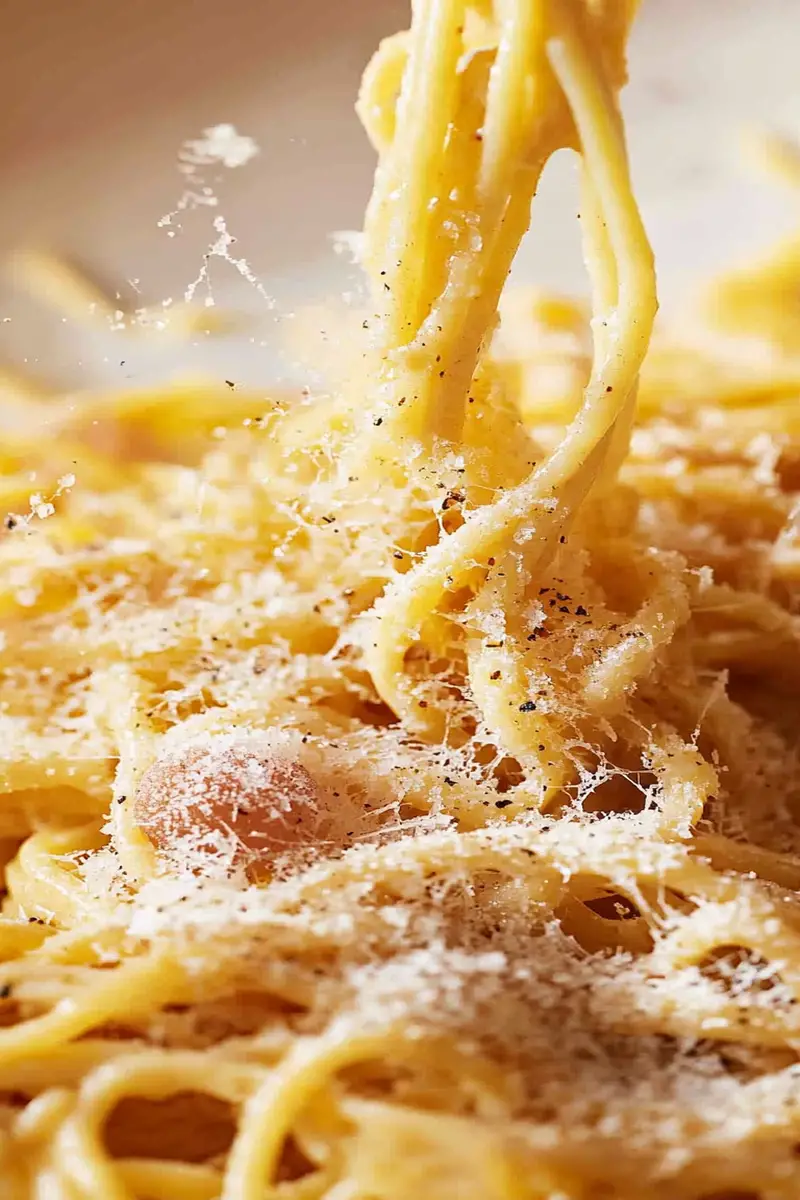
Tips and tricks
To create an excellent spaghetti carbonara, consider using high-quality ingredients. Opt for authentic guanciale if possible, as it provides a unique flavor that bacon or pancetta cannot replicate. The quality of your cheese matters too; Pecorino Romano is the traditional choice, but Parmigiano-Reggiano can be used for a milder flavor. Investing in good ingredients will elevate your dish’s overall taste.
Timing is crucial when preparing spaghetti carbonara. Begin cooking your pasta first so that it finishes around the same time as your sauce preparation. Once your pasta is cooked al dente, quickly drain it while reserving some starchy water for later use in making adjustments to your sauce’s consistency.
Incorporating proper techniques can greatly enhance the outcome of your dish. When mixing the egg yolks and cheese, whisk them thoroughly until smooth before combining them with the hot pasta. This technique prevents scrambling while ensuring that each strand of spaghetti is evenly coated in creamy goodness.
For an added layer of flavor, consider sautéing garlic in olive oil before adding guanciale. However, be careful not to burn the garlic; it should only be lightly golden to avoid bitterness in your dish. This step infuses a subtle garlic essence into the overall meal without overpowering other flavors.
Lastly, presentation plays an essential role in making any dish appealing. Serve spaghetti carbonara immediately after tossing with sauce and finish with freshly cracked black pepper and additional cheese if desired. A sprinkle of parsley can also add color without altering the traditional flavors significantly.
Suggestions for spaghetti carbonara
When preparing spaghetti carbonara, choosing suitable pasta types can enhance texture and flavor combinations significantly. While traditionalists stick with spaghetti, alternatives such as fettuccine or bucatini offer unique experiences due to their shapes and ability to hold sauces differently—experimenting can yield delightful variations while maintaining core flavors.
If you’re looking for additional protein options beyond guanciale, consider incorporating peas or asparagus into your dish for added nutrition and color without compromising authenticity too much—just remember not to overwhelm other essential components like creaminess or richness stemming from eggs and cheese.
For those who may enjoy a slightly smoky flavor profile without deviating too far from tradition, feel free to incorporate smoked paprika sparingly into your egg mixture—it complements existing flavors nicely while introducing depth without being too intrusive on classic notes found in this iconic Italian recipe.
Accompanying side dishes can enhance your meal experience as well! Classic Italian antipasto salads made with fresh greens drizzled lightly with olive oil pair beautifully alongside spaghetti carbonara—providing refreshing contrast against rich elements present within each bite of this beloved comfort food staple!
Lastly, don’t forget about pairing wine appropriately! A crisp white wine such as Pinot Grigio or even a light red like Chianti harmonizes excellently with flavors found throughout this beloved dish—making every bite even more enjoyable when paired thoughtfully alongside sips from perfectly chosen bottles!
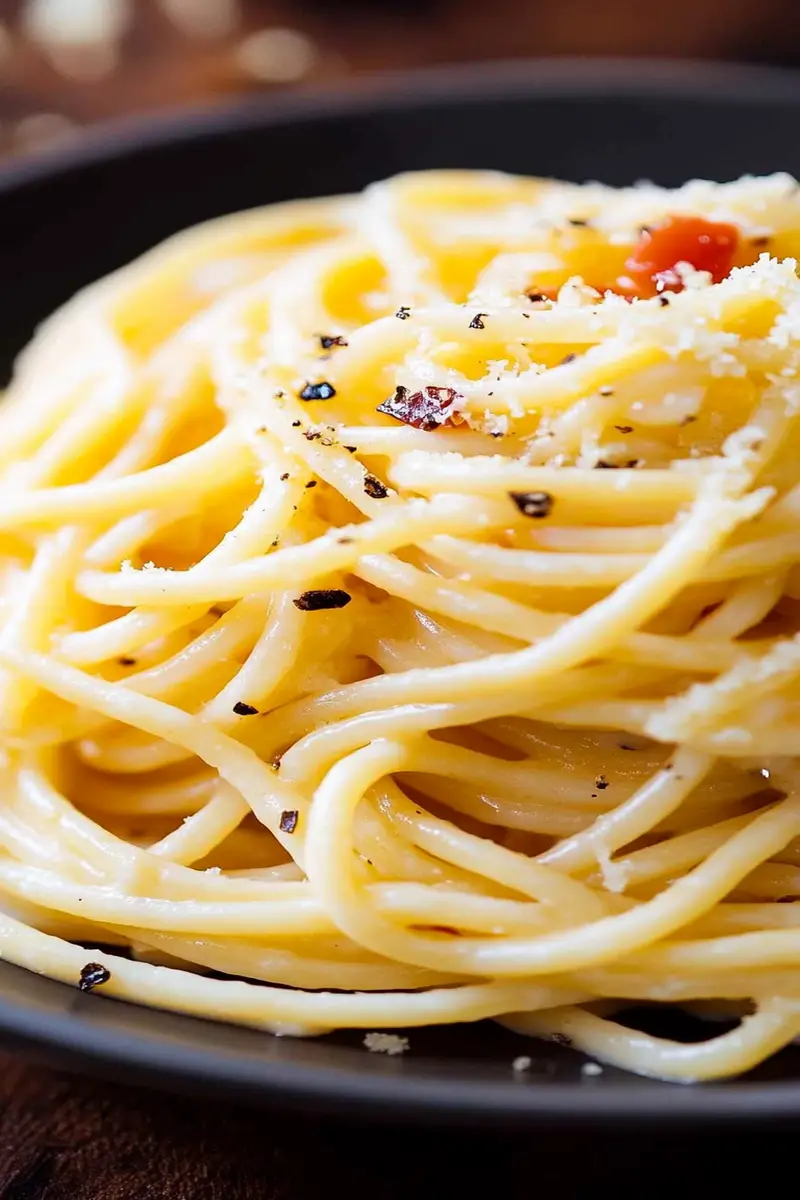
FAQs
What is spaghetti carbonara made of?
Spaghetti carbonara traditionally consists of simple yet flavorful ingredients: spaghetti (or another type of long pasta), guanciale (a type of cured pork cheek), Pecorino Romano cheese, egg yolks (or whole eggs), black pepper, and sometimes garlic or parsley for garnish purposes only—keeping these components intact ensures authenticity remains intact throughout preparation processes involved!
How do I know when my pasta is cooked al dente?
To determine if your pasta has reached that ideal al dente texture requires careful observation during cooking! Start tasting it about one minute before reaching suggested cooking times listed on packages—look for firmness without excessive chewiness; ideally there should be just enough resistance when biting down while still allowing easy swallowing afterward!
Can I use bacon instead of guanciale?
While bacon may seem like an accessible alternative due to its availability compared against guanciale’s rarity outside Italy—this substitution alters both flavor profiles drastically! If seeking authentic results stick closely towards utilizing genuine cured meats available locally instead; however experimenting might yield interesting variations worth trying out too!
Is there a vegetarian version of spaghetti carbonara?
Yes! To create vegetarian adaptations resembling classic versions simply replace meat components using ingredients such as sautéed mushrooms or smoked tofu while keeping egg-based mixtures intact along with cheeses necessary—this approach maintains overall structure while catering towards dietary restrictions folks may have encountered previously!
How long does leftover spaghetti carbonara last?
Leftover servings stored properly within airtight containers typically last about three days within refrigeration! Prioritize consuming leftovers promptly since textures will alter over time resulting potentially less-than-ideal eating experiences later down line—reheating method matters greatly too; consider warming gently on stovetops rather than microwaving directly which could lead uneven heating issues arising instead!
Can I freeze spaghetti carbonara?
Freezing spaghetti carbonara isn’t recommended due largely because dairy elements may separate upon thawing process leading unfavorable textures developing thereafter once reheated again! Best advice would suggest enjoying freshly prepared meals alongside immediate consumption whenever possible maximizing flavors enjoyed within entire experience itself without risking quality degradation during prolonged storage periods afterward!
Conclusion
In summary, making perfect spaghetti carbonara requires attention to detail and adherence to traditional techniques. Avoid common mistakes such as using cream or overcooking pasta by focusing on high-quality ingredients like guanciale and Pecorino Romano cheese instead. Timing is essential; ensure that everything comes together smoothly by starting with well-prepared components beforehand.
Implement tips such as proper mixing techniques and timing strategies while considering additional elements like garlic sautéed alongside meat options can elevate flavors further! Pair with suitable wines and serve alongside light salads for delightful dining experiences all around—all these factors contribute towards creating memorable moments shared at tables filled deliciousness enjoyed collectively amongst family friends alike!
Print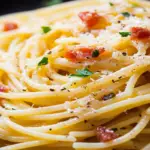
spaghetti carbonara
- Total Time: 25 minutes
- Yield: 4 servings 1x
Description
Spaghetti Carbonara is a classic Italian pasta dish that’s rich, creamy, and full of flavor. Made with simple ingredients like eggs, Parmesan, crispy pancetta, and black pepper, it’s a quick yet indulgent meal that will transport you straight to Italy!
Ingredients
- 12 oz spaghetti
- 4 oz pancetta or guanciale, diced
- 2 large eggs
- ½ cup grated Parmesan cheese
- ½ cup grated Pecorino Romano cheese
- Freshly ground black pepper, to taste
- Salt (for pasta water)
- 1 tbsp olive oil (for frying)
Instructions
- Cook the spaghetti in salted boiling water according to package directions until al dente. Reserve 1 cup of pasta water before draining.
- While the pasta cooks, heat olive oil in a pan over medium heat and fry the pancetta or guanciale until crispy (about 4-5 minutes).
- In a bowl, whisk together the eggs, Parmesan, Pecorino, and a generous amount of black pepper.
- Once the pasta is ready, add it to the pan with the pancetta. Remove the pan from heat.
- Quickly toss the pasta with the egg mixture, adding reserved pasta water a little at a time to create a creamy sauce.
- Serve immediately, garnished with more Parmesan and freshly cracked black pepper.
Notes
- Be careful not to scramble the eggs when adding them to the hot pasta. Toss quickly to create a creamy sauce.
- If you prefer a richer dish, add a bit of heavy cream (although this is not traditional).
- Prep Time: 10 minutes
- Cook Time: 15 minutes

